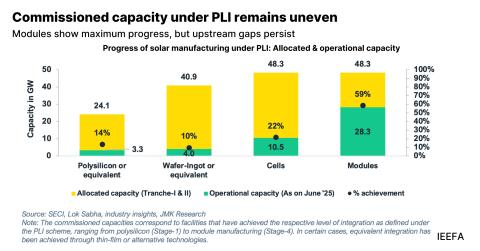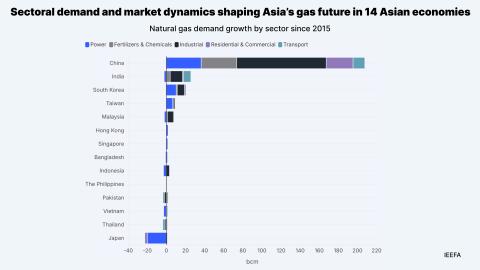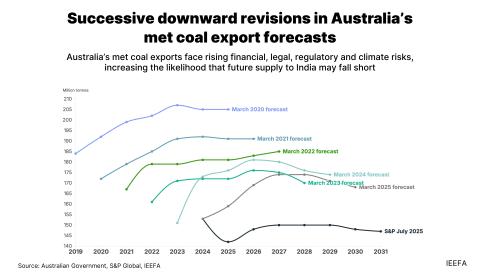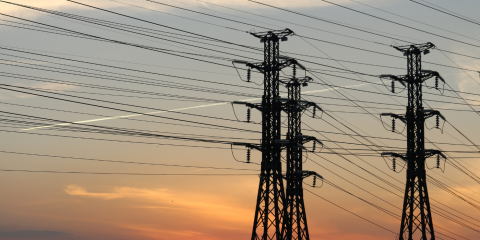Household solar and storage will dramatically change the shape of electricity markets and networks
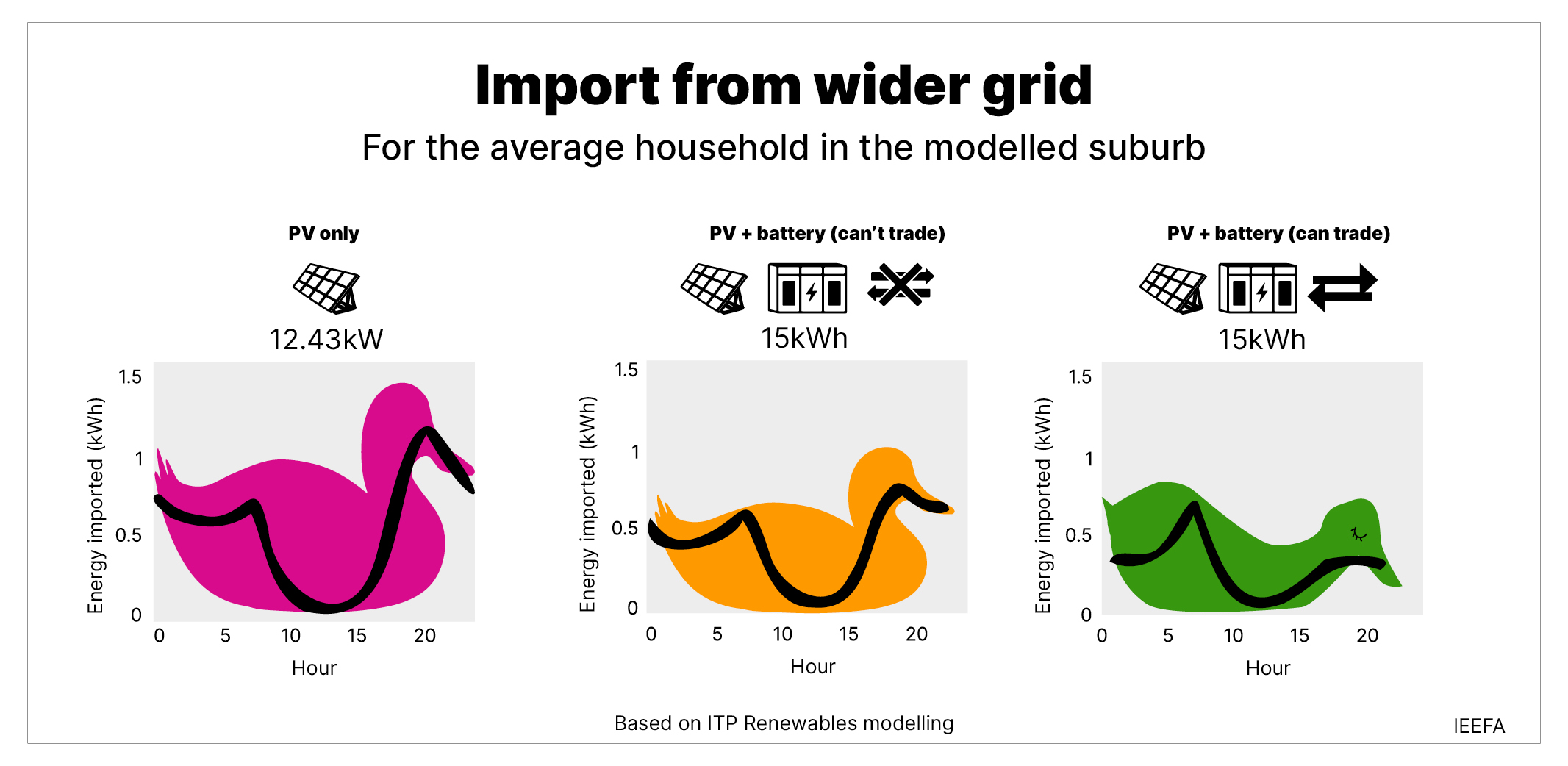
Modelling shows household storage is key to lowering costs
27 April 2023 (IEEFA Australia): IEEFA guest contributor Dr Gabrielle Kuiper says the right regulations could help lower energy costs for all consumers as household solar, storage and load management becomes ubiquitous. For the first time ever, a study has looked at what will happen when Australia will reach saturation levels of distributed energy resources (DER). The study, by ITP Renewables, modelled a range of DER scenarios and found that the costly evening peak could be almost completely eliminated and network peak use in summer could also decrease significantly.
Dr Kuiper said, “Modelling plays a central role in planning for the future of Australia’s energy markets and by turning the concept 180 degrees, ITP Renewables has created a fresh understanding. We know eventually every rooftop in the National Electricity Market (NEM) that can have solar, will. Households will also be all electric with flexible demand in the forms of controlled loads, like hot water and electric vehicles able to be time-shifted to match solar availability.
“We don’t know when this will happen, but we can model what this might look like through a
range of scenarios, starting with 70% of houses with solar, then adding different varieties of DER in sequence to examine the impacts on PV exports, PV export peak, network peaks and high spot price periods. This approach to modelling gives a sense of the consequences for electricity flows locally and through the broader grid for an ‘ideal’ saturation DER suburb in a way that iterative
modelling from the past is unlikely to do. The most significant finding from this fresh approach is that rooftop solar plus batteries will chop the head off the famous solar-created duck curve,” she said.
The more batteries and flexible load in the system, and the easier the regulations make electricity trading by households and businesses, the greater the likelihood of a flatter grid demand/supply curve. Regardless, the 4–8pm peak is the time where generators have traditionally earnt the bulk of their revenue. If this peak no longer exists, there will likely be significant impacts on the spot market. The logical consequences should be significant downward pressure on wholesale spot prices, which benefits all consumers.
Distribution network costs are the largest component of consumer electricity bills even with recent increases in wholesale market prices. Australia’s distribution networks have been built to meet summer evening air-conditioning peaks and the $82.6 billion collective value of the regulated asset bases of the distribution businesses in the NEM is largely based on their capacity to supply electricity from the grid at these times.
Dr Kuiper said, “Rooftop solar exported back into the grid reverses this flow and reduces the need for distribution network capacity. Solar PV alone reduces the summer network peak by almost a third and moves it later in the day, decreasing the average summer network peak by almost two-thirds. There are location-specific issues – for example in Victoria where winter peaks will change with the heating electrification – and networks will need to consider this. In general, however, the study shows that software rather than network investment is needed to cope with increasing electricity flows from DER.”
The Australian Energy Regulator already has approved expenditure for these types of investments in the Victorian distribution networks. The smart software systems can be cost-effectively combined with traditional tools that quickly and cheaply enable more solar, such as transformer tap changes at substations.
Overall, with decreased network peaks, reduced capex would seem logical, and with that, lower distribution charges for customers. The system-level benefits of DER should be passed on to all customers. This requires the Australian Energy Regulator to understand this modelling and, preferably, for the regulation for distribution revenue to be adapted to meet the new circumstances of growing levels of DER.
Dr Kuiper notes that none of the scenarios modelled by ITP Renewables were ideal. They were simply different combinations of technology and enabling conditions. She says that we could create even better outcomes by planning for them. From the insights of ITP’s saturation DER modelling there are some further clear policy directions for the Commonwealth’s energy performance strategy and state government DER policies and programs. These are:
- The Australian Energy Regulator should adapt distribution revenue regulation to meet the new circumstances of growing levels of DER. Ideally, the Australian Energy Market Commission would rethink revenue regulation from first principles given the dramatic changes coming in distribution networks.
- Policies and programs should aim to maximise flexible demand, especially shifting water heating with controlled load to the middle of the day and assisting consumers to switch from gas to smart electric hot water systems.
- Distribution network service providers (DNSPs) should be looking at matching renewable resources and network capacity by location for EV charging. It’s not clear any organisations are taking a system-optimisation view of EV charging and there’s a danger that the lack of EV charging standards and coordination will end up increasing overall costs for consumers. The modelling also looked at scenarios involving ‘neighbourhood’ batteries and further investigation is needed into how these can be used for the greatest benefit for consumers, as opposed to the DNSPs.
- Projects Edith, Edge and Symphony have begun to experiment with targeted remuneration for DER services within a local network area. DNSPs should continue to support this evolving work and the energy market institutions need to ensure consumers can be compensated for the services their behind-the-meter devices can provide to the grid.
- Finally, the Australian Energy Market Operator’s next Integrated System Plan (ISP) should revise its DER uptake forecasts and attempt integrated planning with distribution networks. In particular, the ISP should model as many different scenarios for DER as it does for large-scale renewables. In general, we need energy system and market planning to better understand the implications of high levels of DER on the need for large-scale generation and storage.
Dr Kuiper says that DER has all the advantages of being small, modular and able to be deployed quickly without additional network capex investment. Given the delays to transmission builds and Snowy 2.0, the government needs to put greater focus on renewables and designing the policies, programs and regulations that will lower costs for all consumers by growing levels of DER.
Read the analysis: Saturation DER modelling shows distributed energy and storage could lower costs for all consumers if we get the regulation right
Media contact: Amy Leiper ([email protected]) +61 (0) 414 643 446
About IEEFA: The Institute for Energy Economics and Financial Analysis (IEEFA) examines issues related to energy markets, trends, and policies. The Institute’s mission is to accelerate the transition to a diverse, sustainable and profitable energy economy. (ieefa.org)
About Dr. Gabrielle Kuiper: DER Specialist, Senior Adviser to the Smart Energy Council and a Director at The Superpower Institute, Dr. Gabrielle Kuiper is an energy, sustainability and climate change professional with over twenty years’ experience in the corporate world, government and non-government organisations and academia. She was previously the DER Strategy Specialist with the Energy Security Board. Prior to that, Dr. Kuiper held senior executive or senior advisory energy-related positions in the Office of the Australian Prime Minister, at the Public Interest Advocacy Centre, and in the NSW Government.


